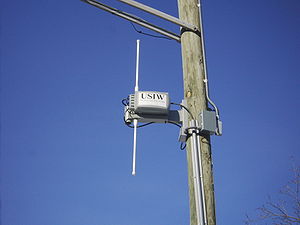
- Image via Wikipedia

- Image via Wikipedia
By Jasmin Melvin
WASHINGTON (Reuters) – U.S. regulators paved the way on Thursday for new, faster wireless devices by opening unused television airwaves for mobile broadband use.
Device makers such as Dell Inc, Nokia and Motorola Inc stand to profit from the Federal Communications Commission’s unanimous vote to allow unlicensed wireless devices to operate on this idle spectrum.
It is the agency’s first significant release of unlicensed spectrum in 25 years, said FCC Chairman Julius Genachowski.
“This new unlicensed spectrum will be a powerful platform for innovation as we’ve seen time and time again when we unleash American ingenuity, great things happen,” he said.
The empty airwaves, called “white spaces,” were freed up during the digital television transition in 2009, and consist of the spaces between existing broadcast channels.
The frequencies allow signals to travel faster, penetrate walls more easily and cover larger geographical areas than current spectrum used for WiFi.
Tech companies have lobbied to deploy a new, super WiFi system using these airwaves that would boost Internet speeds in homes, businesses, schools and municipalities, help bring broadband to rural areas and improve connectivity for mobile devices.
New applications developed to take advantage of the speedier network could annually generate between $3.9 billion and $7.3 billion over 15 years, according to a report commissioned by Microsoft Corp and released last year.
Broadcasters feared such use could interfere with their channels, particularly those used to operate wireless microphones that are relied on for news reporting.
The FCC clarified conditions for use of the unlicensed spectrum to mitigate broadcasters’ concerns, including a requirement that white space devices access a database every 24 hours to check for available spectrum that won’t interfere with broadcaster channels.
Google Inc is among the companies vying to manage the database.
The agency also said two channels would be reserved for wireless microphones in each market, allowing 12 to 16 microphones to operate without any interference. Any need for more capacity would be handled on a case-by-case basis where broadcasters can request more spectrum for large events like major sporting events.
The FCC added that broadcasters could best meet the need for increased capacity for wireless microphones by using more efficient technology, rather than requesting more spectrum.
The National Association of Broadcasters said it was reviewing the ruling. It said its goal is to protect “interference-free access to high quality news, entertainment and sports provided by free and local television stations.”
Successful commercialization of white spaces devices is expected to take at least a year and a half to two years as network operators, chip vendors and device manufacturers develop industry standards.
The FCC also voted on Thursday to ease rules mandating how schools and libraries can use $2.25 billion in federal subsidies to get Internet access, allowing them to take advantage of unused fiber optic cables in localities and high-speed access from state and local networks.
The agency took steps to strengthen and improve the ability of 9-1-1 call centers to quickly and accurately locate wireless callers. Almost two-thirds of emergency calls are made from mobile devices, the FCC said, but emergency responders do not receive accurate location information for up to 40 percent of those calls.
(Reporting by Jasmin Melvin; Editing by Robert MacMillan and Tim Dobbyn)
Related articles by Zemanta
- FCC officially frees TV White Space spectrum (news.cnet.com)
- FCC Opens up ‘white Spaces’ Spectrum to Mobile Devices (pcworld.com)
- FCC rubberstamps rules for ‘WiFi on steroids’ (go.theregister.com)
- FCC Commish: No need for net neutrality; we have white spaces (arstechnia.com)
- New FCC TV White Space Rules (GLGgroup.com)





